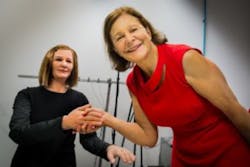A social robot may be coming to a home, office, or institution near you. SoftBank’s four-foot-tall Pepper has already served as a nursing-home helper, having entertained elderly patients. Shunji Iyama, one of Pepper’s developers, notes that Pepper can interact with dementia patients without becoming discouraged by their repetitive speech, as reported in the Wall Street Journal.
Pepper will soon be gaining new capabilities. At last week’s Consumer Electronics Show, IBM and SoftBank announced plans to offer a version of IBM’s Watson cognitive computing technology for Pepper, allowing the robot to tap into the Internet of Things to serve global enterprise customers. IBM said it is currently piloting robotics technology in the hospitality and consumer-packaged-goods industries.
“Today, the power of cognitive computing can be woven into any form factor. Our collaboration with [SoftBank] on Pepper will allow a much broader audience to experience and tap into Watson,” said Mike Rhodin, senior vice president, IBM Watson. “In terms of hands-on interaction, when cognitive capabilities are embedded in robotics, you see people engage and benefit from this technology in new and exciting ways.”
“I am thrilled that we are partnering with IBM on the development of Pepper powered by Watson,” added Fumihide Tomizawa, president of SoftBank. “As a provider of robotics platforms, we seek to enable Pepper’s collaboration with beneficial technologies. I anticipate this collaboration will expand Pepper’s possibilities into an even wider range of fields.”
Watson-powered Pepper would be equipped with core functionalities as well as a Watson software development kit (SDK) that allows developers and clients to tailor the interaction experience. IBM will give clients access to Watson APIs and various pre-packaged applications designed to address a variety of personal and professional needs.
If you are looking for a receptionist, you might consider hiring Nadine, a friendly human-like robot who will greet you, shake your hand, and remember your name the next time you meet. Nadine can be happy or sad, depending on the nature of the conversation you have with her.
Nadine was developed by Prof Nadia Thalmann at Nanyang Technological University in Singapore.
“Robotics technologies have advanced significantly over the past few decades and are already being used in manufacturing and logistics. As countries worldwide face challenges of an aging population, social robots can be one solution to address the shrinking workforce, become personal companions for children and the elderly at home, and even serve as a platform for healthcare services in future,” explained Prof. Thalmann, an expert in virtual humans and a faculty from NTU’s School of Computer Engineering.
“Over the past four years, our team at NTU have been fostering cross-disciplinary research in social robotics technologies—involving engineering, computer science, linguistics, psychology, and other fields—to transform a virtual human, from within a computer, into a physical being that is able to observe and interact with other humans.”
Mike Murphy at Quartz describes Nadine this way: “From a distance, Nadine looks like a very normal middle-aged woman, with a sensible haircut and dress style, and who’s probably all caught up on Downton Abbey. But then you hear Nadine talk and move, and you notice something’s a bit off.” Is there an uncanny valley problem? Quartz has a video—you can judge for yourself.
See related post “If we can be emotionally attached to lamps, we can be emotionally attached to robots.”
About the Author

Rick Nelson
Contributing Editor
Rick is currently Contributing Technical Editor. He was Executive Editor for EE in 2011-2018. Previously he served on several publications, including EDN and Vision Systems Design, and has received awards for signed editorials from the American Society of Business Publication Editors. He began as a design engineer at General Electric and Litton Industries and earned a BSEE degree from Penn State.

